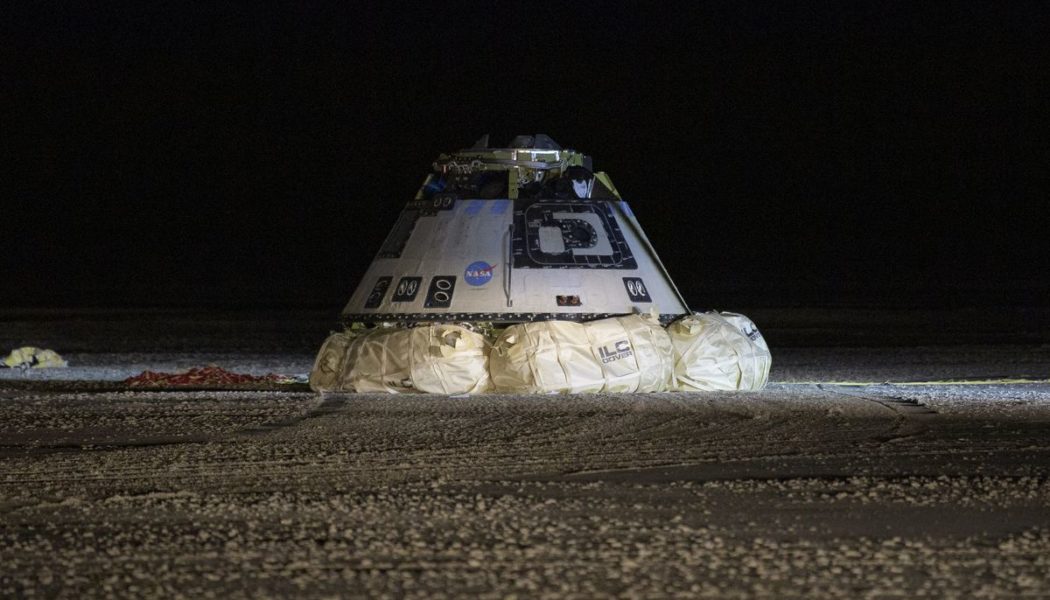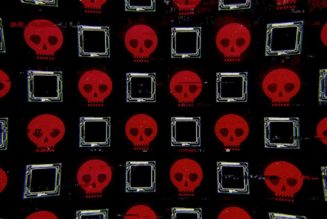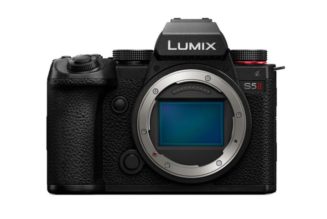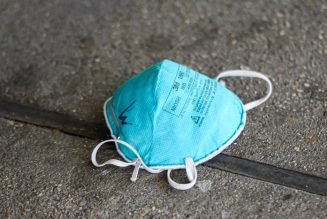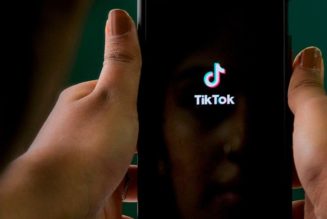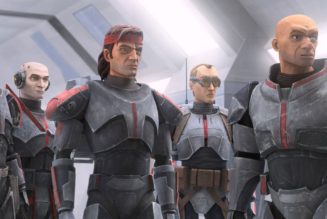Boeing, once a major player in space, has suffered a string of setbacks, failures, and legal challenges in recent years that have chipped away its dominance in the space industry. The company’s space unit has been lapped by Elon Musk’s SpaceX and left to watch on the sidelines as other companies have moved ahead with ambitious programs, from sending astronauts to the International Space Station to returning humans to the surface of the Moon.
On Friday, Boeing will try to mend its reputation during an uncrewed test of its Starliner astronaut capsule to the ISS. This will be the second launch for the capsule, coming a year and a half after its first attempt failed to reach the space station. Eighteen months of grueling technical investigations and a string of leadership shake-ups has brought Boeing back to the launch pad for a $410 million do-over that would put it on track for its first launch with humans aboard later this year. SpaceX, Boeing’s rival in NASA’s Commercial Crew program, is far ahead, with three astronaut missions already under its belt.
The company has seen its once-close relationship with the space agency dwindle since the beginning of its Starliner program. Focusing more on SpaceX, NASA officials overlooked Boeing’s software problems that led to Starliner’s failure. Two investigations, one related to potential fraud in its Starliner program and a criminal probe into Boeing’s bid on a lunar lander contract, pushed the company’s reputation in deeper trouble, locking Boeing out of the first major contracts in NASA’s Artemis program. For Boeing, another Starliner failure is not an option.
“It’s of paramount importance that we have a successful flight,” John Vollmer, Boeing’s Starliner chief, said last week. “This is a serious and unforgiving business, so we take it very seriously… All that we’ve done in the past 18 months, we are very confident that we are going to have a good flight.”
The CST-100 Starliner capsule, a gumdrop-shaped astronaut pod designed to carry cargo and up to seven passengers, will launch without humans on Friday at 2:53PM ET. It’ll carry out the motions of a routine mission: launch to space, dock to the ISS for ten days, then come home — blazing through Earth’s atmosphere at first, then floating under parachutes the rest of the way down to a desert in New Mexico. The mission, called Orbital Flight Test-2, is one of the last tests Boeing needs to nail before its final test, flying a crew of NASA astronauts. Once Starliner wins its NASA certification like SpaceX’s Crew Dragon did last year, up to six operational missions to the ISS for the agency follow. Both companies developed their capsules under the NASA program, with Boeing’s Starliner contract at $4.5 billion and SpaceX’s at $2.7 billion.
Starliner’s 2019 failure
Boeing was banking on success ahead of Starliner’s first orbital test in December 2019. At the time, the company was entrenched in its 737 Max crisis. A clean launch would “restore the Boeing brand,” then-Boeing CEO Dennis Muilenburg told senior NASA officials at Kennedy Space Center hours before liftoff, according to people familiar with the meeting.
But Starliner failed, and Boeing’s board ousted Muilenburg days later. The capsule didn’t reach the ISS and instead returned to New Mexico just two days after launch. Thirty minutes after liftoff, when Starliner was supposed to enter orbit, a series of software failures led the capsule to think it was in a vastly different phase of its mission, causing its suite of onboard thrusters to fire haphazardly, expending crucial amounts of fuel. An unexpected communications blackout prevented mission control from fixing the spacecraft remotely. Once Boeing got Starliner in a shallow orbit, it decided to send the capsule home early. Hours before Starliner was due to reenter, engineers scrambled to patch another software glitch that would have caused the capsule’s service module — the bottom portion that ejects before reentry — to crash into the capsule itself. Once “catastrophic spacecraft failure” was averted — as NASA safety adviser Paul Hill would describe it months later — Starliner landed safely in the New Mexico desert.
:no_upscale()/cdn.vox-cdn.com/uploads/chorus_asset/file/22745822/1190261866.jpg)
NASA and Boeing convened an independent team of veteran engineers to investigate the causes of Starliner’s failures, eventually recommending 80 different fixes — 61 to Boeing’s software and 19 to the capsule’s communications system. Boeing and NASA agreed to a test redo since Starliner never demonstrated its ability to dock to the station. “That’s the part of the flight that, to me, is so critical,” NASA’s Commercial Crew Program manager Steve Stich told reporters on Tuesday. The redo and “several performance items” for Starliner cost Boeing at least $410 million, Greg Smith, the company’s then-chief financial officer, said in an earnings call.
Boeing has since overhauled the way it tests and validates its software, both on Starliner and across some of its other NASA programs, like its Space Launch System rocket. Starliner’s communications system was upgraded and Boeing hired a new software VP from SpaceX, Jinnah Hosein. Months before Friday’s mission, the company had simulated a full test mission for the first time, from launch to ISS docking to landing — something it didn’t do prior to Starliner’s first mission. That’s on top of “hundreds of hundreds” of other simulations totaling “literally thousands of hours,” Vollmer told reporters on Tuesday. All 80 corrections recommended by the independent Boeing-NASA team have been made, which involved a “relatively small set” of flight software changes, Vollmer said.
Though Starliner is back at its launch site, Boeing’s relationship with NASA has taken lasting hits. NASA has shifted toward leaner, cheaper contracting models intended to make the agency a customer — not an owner — of spacecraft developed by companies mainly with their own funds. Boeing, a publicly traded aerospace giant, is accustomed to the opposite: building hardware that NASA will exclusively own under larger development contracts that come with incentives for the contractor.
:no_upscale()/cdn.vox-cdn.com/uploads/chorus_asset/file/22745877/boeing_starliner.jpeg)
Boeing’s waning relationship with NASA
With the private, fixed-price model of its Starliner contract, Boeing bears more responsibility and risk than it is used to. Its work on such programs has been cited in financial filings as “inherently risky” that “subject us to the risk of reduced margins or incurring losses if we are unable to achieve estimated costs and revenues.” With SpaceX’s Crew Dragon far ahead in operations, and Jeff Bezos’ Blue Origin fiercely competing for more lunar lander funds, Boeing is struggling to adapt to mounting competition from the billionaire-backed space companies. NASA, too, has struggled under this commercial shift. The agency, under political pressure to end its reliance on Russia’s space program for rides to the space station, has also faced pressure from Boeing to bend the rules of its fixed-price Starliner contract.
In 2019, $661 million worth of Boeing deals with NASA were investigated for fraud by the agency’s inspector general 2019, according to documents obtained from a Freedom of Information Act request. That investigation, previously unreported, focused on two deals that, taken together, raised concerns among auditors of procurement fraud as Boeing was on the verge of canceling its Starliner contract. One involved a $287 million boost to Boeing’s Starliner contract in late 2016, and another involving Boeing’s sale of $374 million worth of Russian Soyuz seats to NASA two months later in 2017. The investigation sheds some light on an early instance where Boeing’s relationship with NASA began to strain.
For the Starliner deal in late 2016, Boeing asked NASA to raise the value of its fixed-price Starliner contract after running into months of development delays that Boeing itself caused. As fixed-price contracts typically require the contractor to bear the cost of falling behind, not the agency, several NASA attorneys initially objected to Boeing’s proposal over fears it would violate the contract, according to a partially redacted document NASA refused to release until The Verge filed a FOIA appeal. But Boeing, according to four people with first-hand knowledge of the private discussions, threatened to drop out of the Commercial Crew Program if NASA didn’t agree to the contract boost (Boeing denied this in 2019, issuing a statement that said “any implication that we ever wavered in our participation in Commercial Crew is false). NASA ultimately agreed to the $287 million boost, justifying its payment by citing fears that recent rocket failures with SpaceX and Russia’s Soyuz rocket would jeopardize the agency’s ability to send astronauts to the ISS in the next two years. In exchange, Boeing agreed to speed up the time it’d take to build Starliner capsules for crewed missions it said would occur as early as 2019. Boeing has yet to fly humans under the program.
:no_upscale()/cdn.vox-cdn.com/uploads/chorus_asset/file/22745858/935878688.jpg)
Around the same time, Boeing entered settlement talks in an unrelated lawsuit with Russian rocket firm Energia, where it would obtain the rights to five astronaut seats on Russia’s Soyuz launch vehicle. Boeing offered to sell those seats to NASA for $374 million five days after the agency agreed to the $287 million Starliner boost. NASA ended up buying the seats from Boeing to solve the same schedule issue Boeing’s Starliner commitment was supposed to solve. Highly unusual, it marked the first time NASA bought Russian astronaut seats from a non-Russian entity.
Two years later, auditors with NASA’s inspector general examined the Starliner and Soyuz deals and referred their findings to the inspector general’s investigative unit for a fraud probe, according to a case memo. Investigators within that unit closed the case, finding that auditors’ concerns about the deals were “valid” but “less-than-optimal contract administration did not equate to fraud.” Boeing and NASA have defended the deals. When it was first reported in a public audit, Boeing said it was taking on “significantly more upfront financial risk and is already helping NASA with critical decisions” on the space station, and that without getting the extra $287 million, the original contract structure would have “increased cost and schedule uncertainty.”
Boeing ran into more problems in 2020 when it sought to compete for a contract in NASA’s multimillion-dollar lunar lander program. The company was removed from the competition and became the target of a Justice Department investigation when its senior vice president for space and launch, Jim Chilton, discussed Boeing’s bid with NASA’s then-human exploration chief Doug Loverro. The conversation occurred while the agency was reviewing company proposals — a strict “blackout” period where agency contact with bidders is highly restricted. Loverro resigned, and Boeing reached an agreement with NASA that forced the company to carry out a private review of its ethics culture. Boeing fired an in-house attorney and a few employees.
:no_upscale()/cdn.vox-cdn.com/uploads/chorus_asset/file/22745870/1195079506.jpg)
The investigations into Boeing’s Starliner deal and its role in NASA’s lunar lander competition stained the company’s space program. While space might not be a strong source of revenue for Boeing, participating in off-world missions is a source of company pride that boosts its brand and paves a path to future space ventures, including space tourism. “Allowing private citizens to experience the wonder of spaceflight is part of our future plans for Starliner,” Boeing spokesman Josh Barrett said.
A successful Starliner mission would be a heavily needed win for Boeing after years of technical and management struggles. The company, though, still has a lot to learn about the spacecraft, and Friday’s flight is vital for its plans. “There are systems on this vehicle that we need to fully understand how they operate in the environment of space,” Vollmer said Tuesday.
“Will there be some learning? There absolutely will be some learning. It’s a test flight.”
